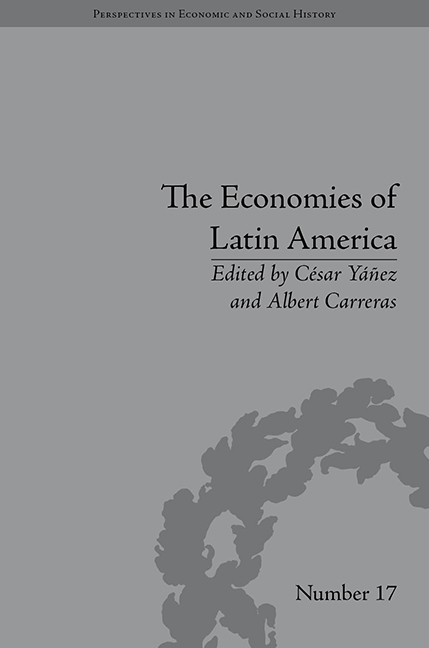Book contents
- Frontmatter
- CONTENTS
- List of Figures and Tables
- List of Contributors
- Preface
- Introduction: Latin American Economic Backwardness Revisited
- 1 Expectations, Institutions and Economic Performance: Latin America and the Western European Periphery during the Twentieth Century
- 2 On the Accuracy of Latin American Trade Statistics: A Non-Parametric Test for 1925
- 3 Latin America and Its Main Trade Partners, 1860–1930: Did the First World War Affect Geographical Patterns?
- 4 The Structure of Latin American Investment in Equipment Goods during the Mature Period of the First Globalization
- 5 Factorial Distribution of Income in Latin America, 1950–2000: New Series from the National Account Data
- 6 The Influence of the First World War on the Economies of Central America, 1900–29: An Analysis From a Foreign Trade Perspective
- 7 Economic Modernization in Adverse Institutional Environments: The Cases of Cuba and Chile
- 8 Capital Goods Imports, Machinery Investment and Economic Development in the Long Run: The Case of Chile
- 9 The Sugar Industry, the Forests and the Cuban Energy Transition, from the Eighteenth Century to the Mid-Twentieth Century
- 10 Empirical Debate on Terms Of Trade and the Double Factorial Terms of Trade of Colombia, 1975–2006
- 11 Public Revenues in Bolivia, 1900–31
- 12 The Consumption of Durable Goods in Latin America, 1890–1913: Analysis and Estimation of a Demand Function
- Notes
- Index
9 - The Sugar Industry, the Forests and the Cuban Energy Transition, from the Eighteenth Century to the Mid-Twentieth Century
- Frontmatter
- CONTENTS
- List of Figures and Tables
- List of Contributors
- Preface
- Introduction: Latin American Economic Backwardness Revisited
- 1 Expectations, Institutions and Economic Performance: Latin America and the Western European Periphery during the Twentieth Century
- 2 On the Accuracy of Latin American Trade Statistics: A Non-Parametric Test for 1925
- 3 Latin America and Its Main Trade Partners, 1860–1930: Did the First World War Affect Geographical Patterns?
- 4 The Structure of Latin American Investment in Equipment Goods during the Mature Period of the First Globalization
- 5 Factorial Distribution of Income in Latin America, 1950–2000: New Series from the National Account Data
- 6 The Influence of the First World War on the Economies of Central America, 1900–29: An Analysis From a Foreign Trade Perspective
- 7 Economic Modernization in Adverse Institutional Environments: The Cases of Cuba and Chile
- 8 Capital Goods Imports, Machinery Investment and Economic Development in the Long Run: The Case of Chile
- 9 The Sugar Industry, the Forests and the Cuban Energy Transition, from the Eighteenth Century to the Mid-Twentieth Century
- 10 Empirical Debate on Terms Of Trade and the Double Factorial Terms of Trade of Colombia, 1975–2006
- 11 Public Revenues in Bolivia, 1900–31
- 12 The Consumption of Durable Goods in Latin America, 1890–1913: Analysis and Estimation of a Demand Function
- Notes
- Index
Summary
Introduction
Cuba in the mid-eighteenth century was striking for having a higher level of economic activity than countries such as the United States and Argentina. However, at the beginning of the nineteenth century it started to lag behind the rest.
Authors such as Coatsworth, Sokoloff and Engerman point out that the success of countries like Cuba can be attributed to the combination of a relatively scarce workforce (free and slave) and access to abundant natural resources. Landes adds that this led to the utilization of a large part of the territory for sugar-cane cultivation and the importation of all provisions – as tended to be the pattern in the plantation economies. Moreover, this type of societal organization led to enormous inequalities in income distribution and to the emergence of bad institutions which became entrenched over time. These are the elements commonly used to explain how the rapid initial growth was later stunted and also to explain Cuba's present-day backwardness. However, this type of economic specialization also led to the near disappearance of Cuba's forests. This is a little-studied subject.
Generally, the process of Cuban economic growth has been associated with two factors: the availability of cheap energy obtained from the forests (where the land was the cheapest and most abundant productive factor on the island, in relative terms) and the availability of a slave workforce during the eighteenth and nineteenth centuries. These two elements defined Cuban economic growth potential along the lines of Boserup's bubble.
- Type
- Chapter
- Information
- The Economies of Latin AmericaNew Cliometric Data, pp. 131 - 146Publisher: Pickering & ChattoFirst published in: 2014



